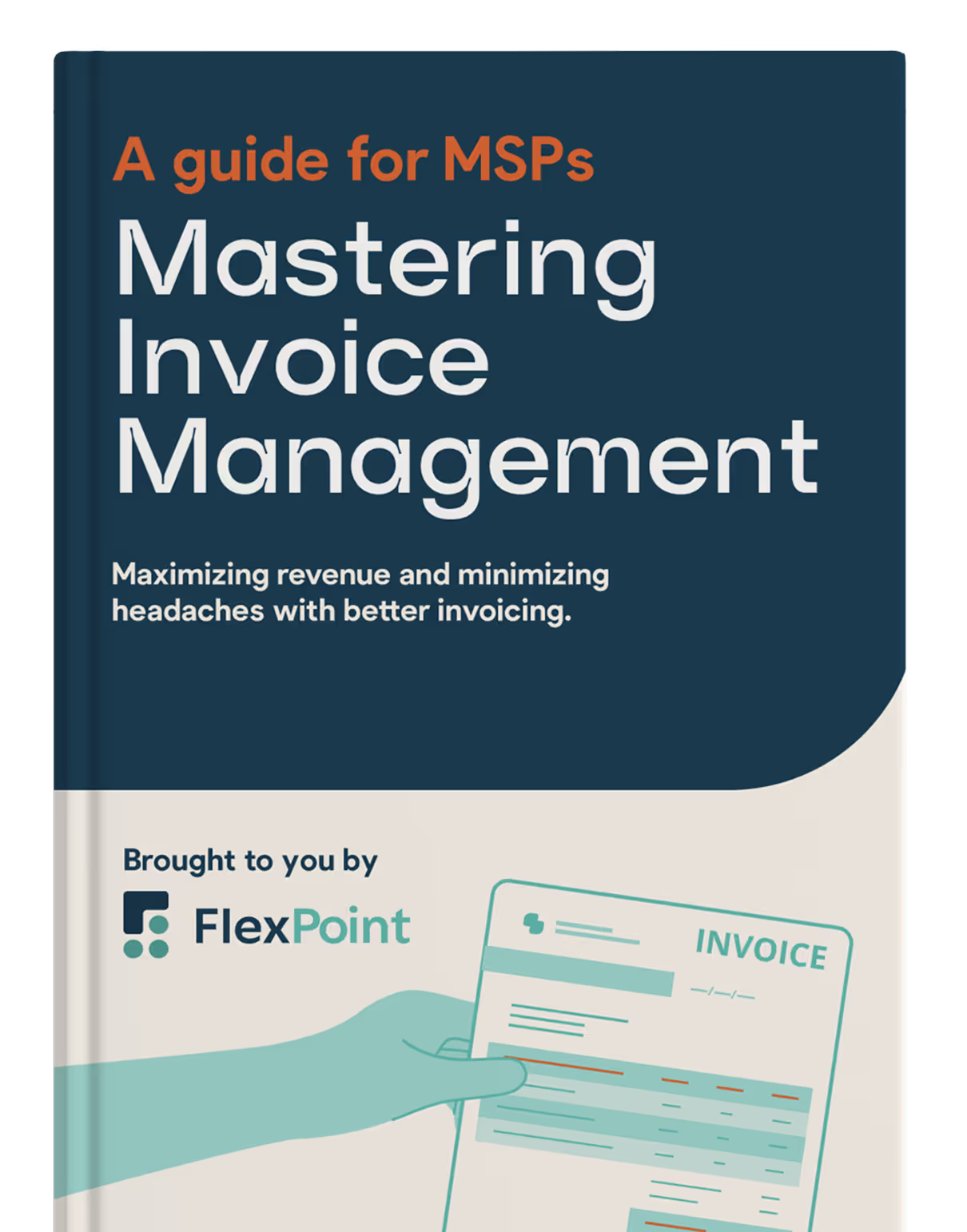MSP Per Device Pricing: Is It Still the Right Model for Today’s Market?
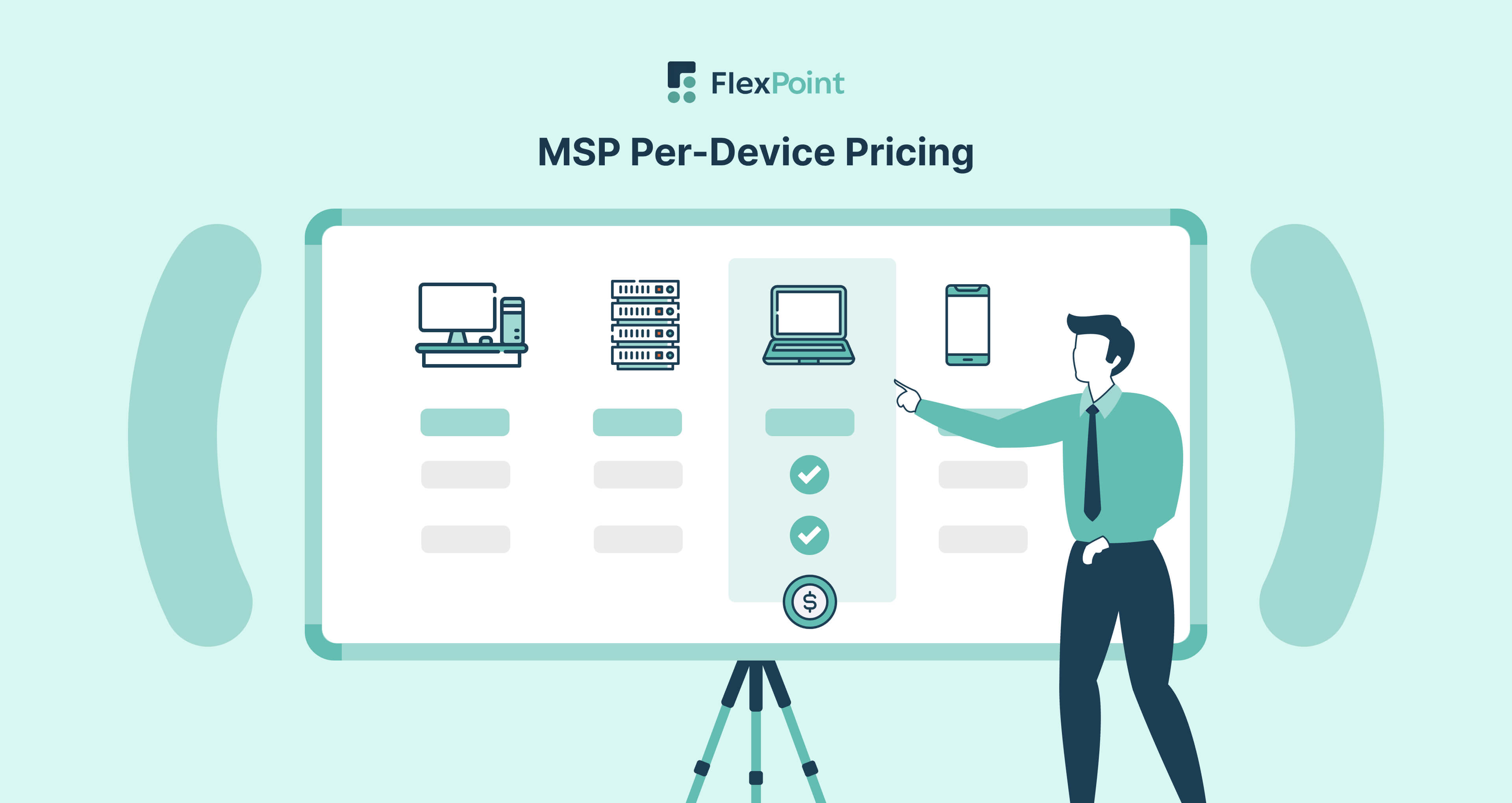
For managed service providers (MSPs), the billing model you choose can affect client relationships, internal efficiency, and overall profitability. One of the most commonly used structures is per-device pricing. It has served MSPs well for years, offering simplicity and predictable revenue.
However, the needs of today’s clients are changing. Hybrid work, multi-device use, and outcome-based expectations are pushing providers to reevaluate traditional billing models. What once felt straightforward may now seem outdated in complex environments.
In this article, we will break down per-device pricing, including what it is, where it works, and why some MSPs are moving away from it. You’ll learn how to evaluate whether it still aligns with your business model and how modern tools, such as MSP-specific billing software, support a shift toward more adaptive billing approaches.
Whether you’re just starting out or looking to update your current model, this guide will help you determine if per-device pricing aligns with your growth plans.
{{toc}}
What Is MSP Per-Device Pricing?
Per-device pricing is a billing structure where clients are charged based on the number of managed devices. This could include desktops, laptops, servers, printers, or mobile phones. Each device type typically has a set monthly fee that covers specific services, including monitoring, patching, and antivirus protection.
For example, an MSP might charge $100 per workstation and $250 per server each month. That fee stays consistent regardless of how much support each device actually requires. In this model, billing is tied to inventory rather than usage.
The appeal lies in its simplicity.
Clients can easily understand how their bill is calculated. For MSPs, it often means predictable revenue and fewer payment disputes.
Adding a new device? The invoice goes up.
Remove one? The cost drops.
However, simplicity has limits. As IT environments become more complex, charging per device may not reflect actual support needs or value delivered. Businesses with bring-your-own-device (BYOD) policies or hybrid (remote and in-office) setups may find this model hard to reconcile with real-world use. Still, it remains a go-to choice for many smaller MSPs or those with clients in traditional office environments.
{{ebook-cta}}
Pros and Cons of Per-Device Pricing for MSPs
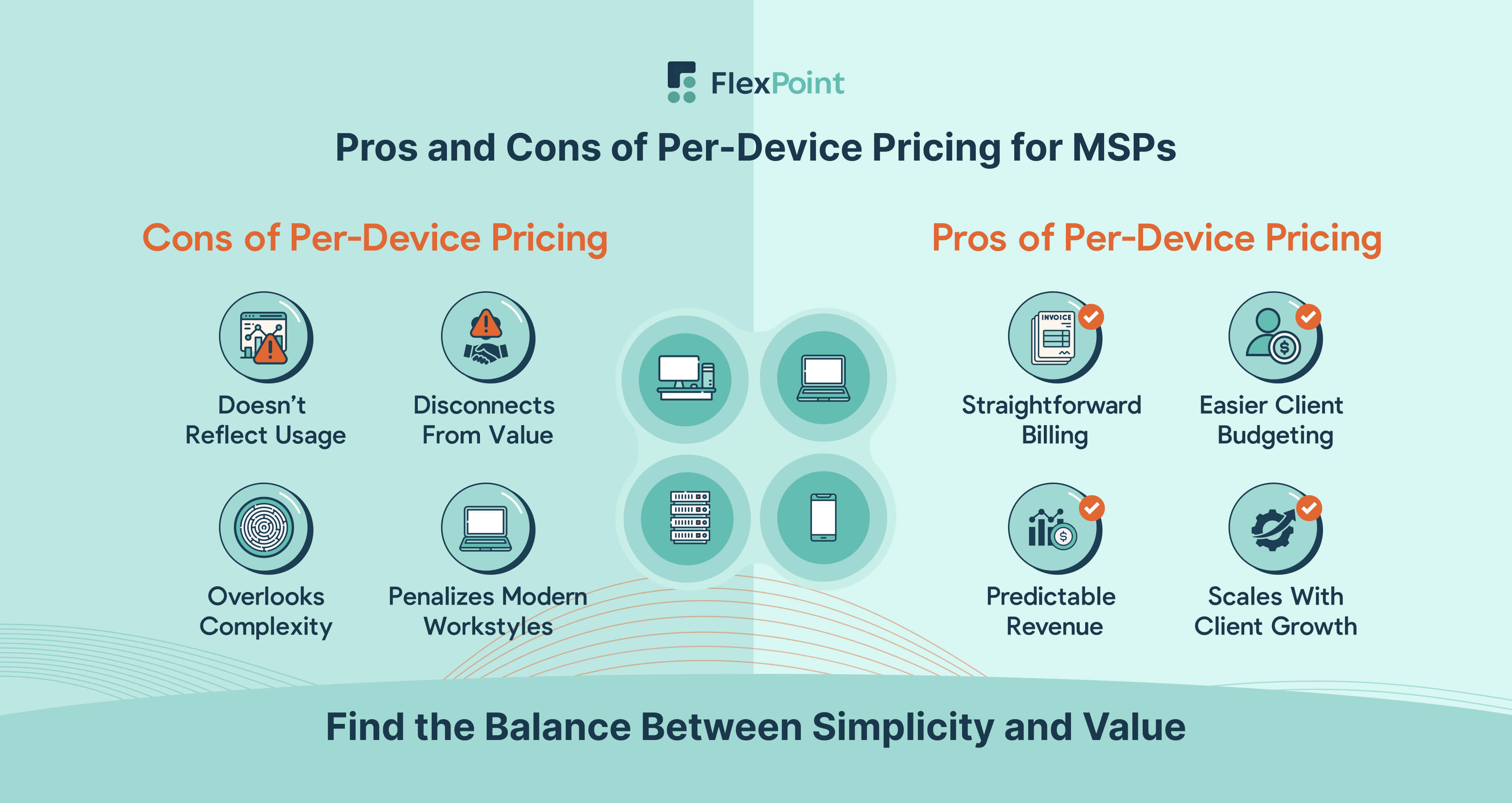
Before deciding whether to keep or drop per-device pricing, MSPs need to understand what this model does well and where it tends to break down. Each advantage and drawback reflects how the pricing structure affects operations, billing transparency, and client relationships.
This section outlines both the strengths and weaknesses of per-device pricing. By examining each side, you can better assess whether this model aligns with your current service delivery and financial goals.
The Pros of Per-Device Pricing:
- Straightforward Billing: Per-device pricing is easy to explain. Clients understand what they’re paying for, and invoices match the asset list. This clarity helps avoid confusion during onboarding, quarterly reviews, and renewal discussions. For sales teams, it's a selling point that reduces the need for in-depth billing explanations.
- Predictable Revenue: Since device counts rarely fluctuate significantly, monthly income remains relatively stable. MSPs can more confidently forecast revenue and plan hiring or investment based on steady billing volumes. This level of predictability also aids in financial planning and when seeking funding or credit.
- Easier Client Budgeting: When clients understand the cost of each device, budgeting for IT support becomes straightforward. Decision-makers can calculate projected expenses for upcoming hires, office expansions, or refresh cycles. The transparency in unit pricing also minimizes resistance during the procurement process.
- Scales with Client Growth: As clients add more devices, your revenue increases naturally. This model rewards MSPs as their clients expand, making it easier to justify the added workload that comes with growth. As infrastructure grows, so does the MSP's ability to forecast resource allocation and service delivery needs.
The Cons of Per-Device Pricing:
- Doesn’t Reflect Usage: A server in a small branch office requiring minimal support might be billed at the same flat rate as a server in a large branch office that demands constant maintenance. This flat-rate approach overlooks the true cost and effort required to support the high-maintenance server, making the case for a usage-based billing model.
- Overlooks Complexity: Not all devices are created equal. Aging hardware or poorly configured systems may require more time, but still incur the same fee. MSPs may end up losing money on accounts that require disproportionate support.
- Disconnects from Value: Clients may question why they’re paying per gadget rather than for outcomes, such as uptime or security. When pricing doesn’t reflect the business results delivered, it can feel arbitrary or commoditized.
- Penalizes Modern Workstyles: In a world where each employee may use two or three devices, costs can escalate quickly. Clients may view this as unfair or outdated, particularly when compared to per-user pricing models that more accurately reflect actual usage patterns.
While the model works for some, its limitations become more noticeable as client environments evolve. MSPs need to weigh predictability against the risk of underpricing or misaligning with how their clients actually operate.
When Per-Device Pricing Works – and When It Doesn’t
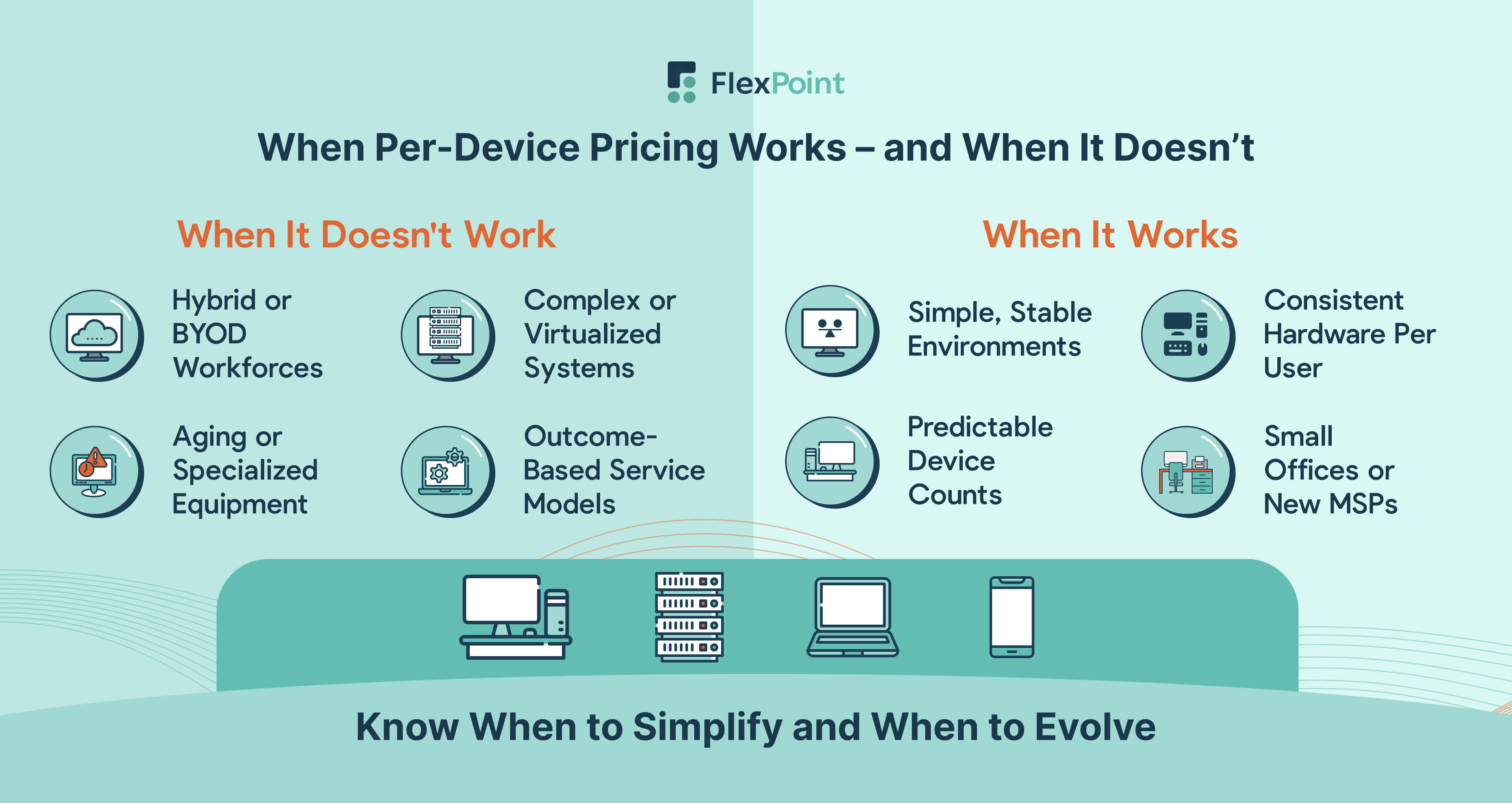
Per-device pricing still has a place in today’s MSP market. It works best when client environments are simple and consistent. For example, in small offices with one device per user and little variation in hardware.
MSPs that serve clients with stable infrastructures, such as accounting firms or legal practices, often benefit from this model. It allows for easy forecasting and minimal administrative overhead. It also suits MSPs who are just starting out and want a model that’s quick to implement.
Conversely, the model struggles with hybrid work and BYOD setups. When employees use personal devices or switch frequently between hardware, keeping track becomes challenging. Clients may resist paying for every endpoint they don’t consider essential.
Complex environments pose another challenge. Businesses that use a mix of virtual machines, IoT devices, and remote tools may require more support than the per-device fee can justify. Older servers or specialized equipment may consume more time, but they still incur the same flat rate.
Finally, this model doesn’t align with MSPs offering results-focused services. When your value lies in business outcomes such as uptime guarantees or compliance management, it becomes harder to justify pricing based only on device counts. In such cases, alternative billing models may be more suitable.
Exploring Alternatives to Per-Device Pricing
As MSPs take on more complex client environments, many find that traditional per-device pricing no longer reflects the full value of their services. Billing solely based on hardware often overlooks how people use technology, the outcomes it delivers, and the growing demand for flexibility.
This section outlines three alternative billing models that address some of the limitations of per-device pricing. Each offers a way to align fees with usage patterns, business impact, or specific service levels. Whether you want to simplify billing across multi-device users or emphasize results over endpoints, these models offer strategic advantages.
Below, we’ll cover per-user pricing, value-based pricing, and hybrid pricing approaches, along with how FlexPoint helps MSPs implement and manage them with ease.
1. Per-User Pricing
This model charges based on the number of users, regardless of the number of devices each person uses. It aligns better with modern work environments where users often have multiple endpoints.
Per-user pricing also reflects the real driver of support volume: people, not hardware.
This billing model simplifies billing by tying it to headcount, which tends to change less frequently than device inventories. It also creates clearer expectations for service coverage. This helps m
2. Value-Based Pricing
Rather than billing for devices or users, the value-based pricing model focuses on outcomes.
Clients pay for services tied to business results, such as guaranteed uptime or regulatory compliance. It shifts the conversation from equipment to value.
This approach is especially beneficial when your MSP offers strategic services that drive measurable improvements. It encourages long-term partnerships built on trust and performance, rather than transactional support.
Value-based pricing also allows room for higher profit margins when services consistently deliver strong client outcomes.
3. Hybrid Models
Many MSPs combine billing methods. For example, you might use per-user pricing for helpdesk support but charge per server for infrastructure management. Hybrid pricing models allow flexibility while maintaining some structure.
This approach works especially well when client needs vary widely or when a single pricing model doesn’t cover all service types. You can adapt your billing to match the complexity of the engagement while ensuring consistency across accounts.
Hybrid models also give MSPs more options during client negotiations and make it easier to scale pricing as services expand.
As MSPs grow, flexibility in pricing becomes more important. Clients want transparency. You want profitability. Using tools that let you support multiple billing models helps you serve both goals.
A robust MSP Billing platform like FlexPoint supports all of these billing strategies. Whether you choose per-device, per-user, or a blend, the platform lets you set custom rules and automate invoices accordingly.
The software also simplifies reporting and reconciliation. That means fewer manual calculations and fewer billing errors. When switching models or testing new structures, FlexPoint’s MSP billing software adapts without disrupting operations.
Conclusion: Choosing the Right Pricing Model for Your MSP
Choosing the right MSP pricing model affects more than just monthly revenue. It influences client retention, operational clarity, and long-term growth. Per-device pricing offers structure and predictability, but its relevance depends on your clients and the services you provide.
For MSPs working with small businesses that have simple device setups, the model can still be a good fit. It delivers stable revenue and minimal complexity.
However, if your clients are embracing hybrid work, utilizing more cloud tools, or prioritizing business outcomes, you may need a model that reflects these changes.
Per-user pricing might make more sense where users juggle multiple devices. Value-based pricing may be ideal if your services center on measurable business results. Hybrid models enable you to tailor billing to the services delivered, ensuring you’re fairly compensated for both standard and high-effort work.
FlexPoint gives you the flexibility to make that choice. The platform supports any pricing model and simplifies complex billing logic. Whether you’re transitioning from per-device pricing or already managing multiple models, FlexPoint automates what would otherwise be a manual and error-prone process.
What’s most important is aligning pricing with value. When clients understand what they’re paying for and believe it reflects the service they receive, they’re more likely to stay and grow with you.
Whether you’re using per-device pricing or exploring new billing strategies, FlexPoint supports your MSP billing and growth.
Automate invoicing, gain pricing flexibility, and improve revenue consistency.
Schedule a demo to see how FlexPoint adapts to your pricing model.
{{demo-cta}}
Additional FAQs: MSP Per-Device Pricing
{{faq-section}}



